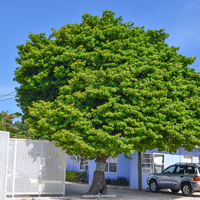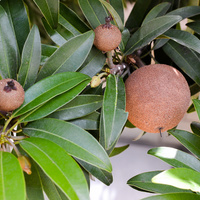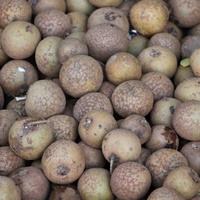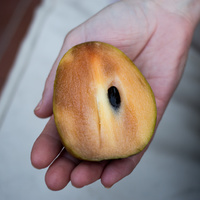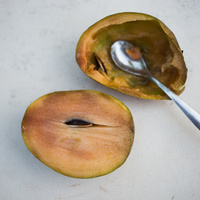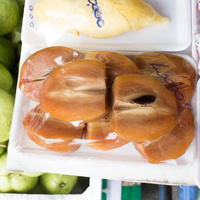Common name: Sapodilla
Other common names: Dilly, Naseberry, Neeseberry, Sapodilla plum
Description
Sapodilla is a fruit-bearing and latex-producing tree originating in tropical America, its natural range extending from Mexico, through Central America, to northern parts of South America. Nowadays, it is widely cultivated for its fruit in many subtropical and tropical regions around the world.
A tall tree in native forests, it may reach heights of up to 40 m (130 ft) with a straight, round trunk up to 1.5 m (5 ft) in diameter. On open sites, it is more typically a medium-sized tree 9 to 15 m (30 to 50 ft) tall with a low-branching trunk supporting a densely leafy, rounded crown. The bark is dark brown, rough, and on wounding yields a sticky white latex, as do all other parts of the tree.
The leaves are elongated oval, 3 to 13 cm (1.2 to 5.2 in) long, tapered at both ends, dark glossy green on top, dull green underneath and spirally arranged at the ends of the branches. They remain on the tree throughout the year.
The flowers are small, white, bell-shaped and borne singly at the leaf bases. They bloom to their fullest in the rainy season but may also bloom on and off in constantly humid areas.
Fertilised flowers develop into egg-shaped fruit, 5 to 10 cm (2 to 4 in) long, maturing four to five months after fruit-set. They have thin, rough, brown skin surrounding brownish pulp with three to six glossy black seed at the centre.
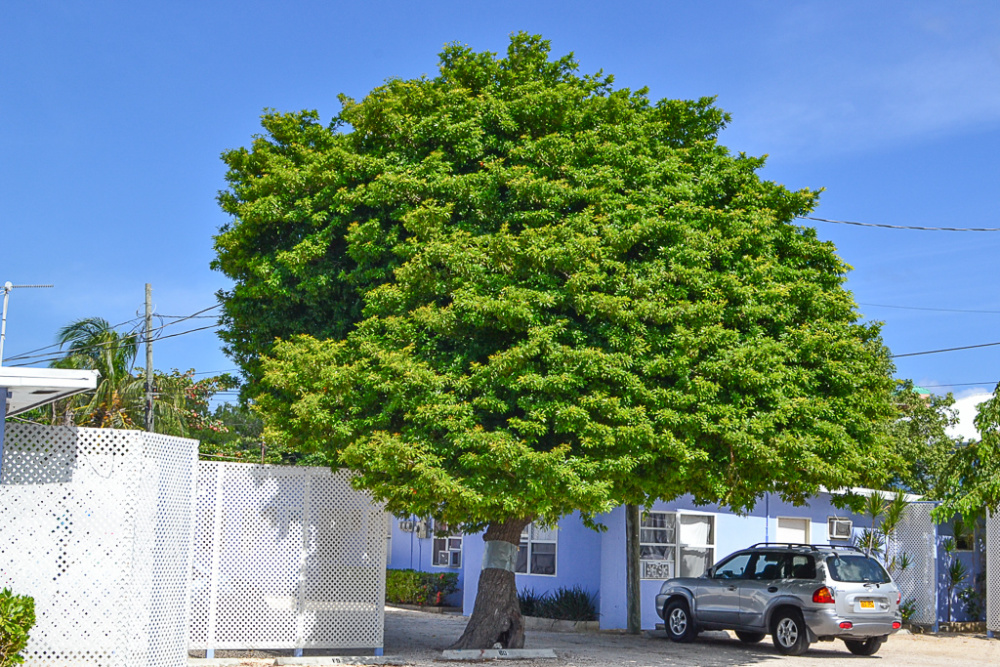
Sapodilla tree (Cayman Islands)
Use
The fruit are harvested when mature but still firm to the touch, and then they are set aside for a few days until they become soft, which indicates their readiness for eating.
They are mostly eaten out-of-hand, either sliced in half or pulled apart and the pulp scooped out with a spoon, leaving the seed behind. The pulp is soft, juicy, melting, mildly gritty and sweet, reminding somewhat of brown sugar or caramel. Sometimes a squeeze of lime juice is added to counter the sweetness. It is suitable for incorporating in desserts such as fruit salad and is easily pureed and smoothed with milk, cream or yoghurt.
The bark on wounding yields a sticky, white latex known as 'Chicle', which is tapped similarly to rubber latex from the Rubber tree (Hevea brasiliensis). V-shaped incisions are made in the bark and arranged to allow the latex to flow in a stream down to the base, where it is collected in a receptacle. This method yields per tree from 1.0 to 3.5 kgs (2.2 to 8 lbs) of latex annually, depending on the size of the tree and the growing conditions.
Chicle latex is coagulated by heating it to form chicle gum, the base of chewing gum, a widely consumed masticatory in the United States and other countries. Chewing gum is usually sweetened and flavoured either with mint, cinnamon, ginger, vanilla or fruit.
The wood is dark red, very hard and heavy, averaging about 860 kgs per cubic meter (54 lbs per cubic ft), with good natural resistance to rot and decay. When available, it is used in heavy construction, railway sleepers and for making tool handles. However, the tree is not usually felled in areas where the fruit is eaten or the latex collected.
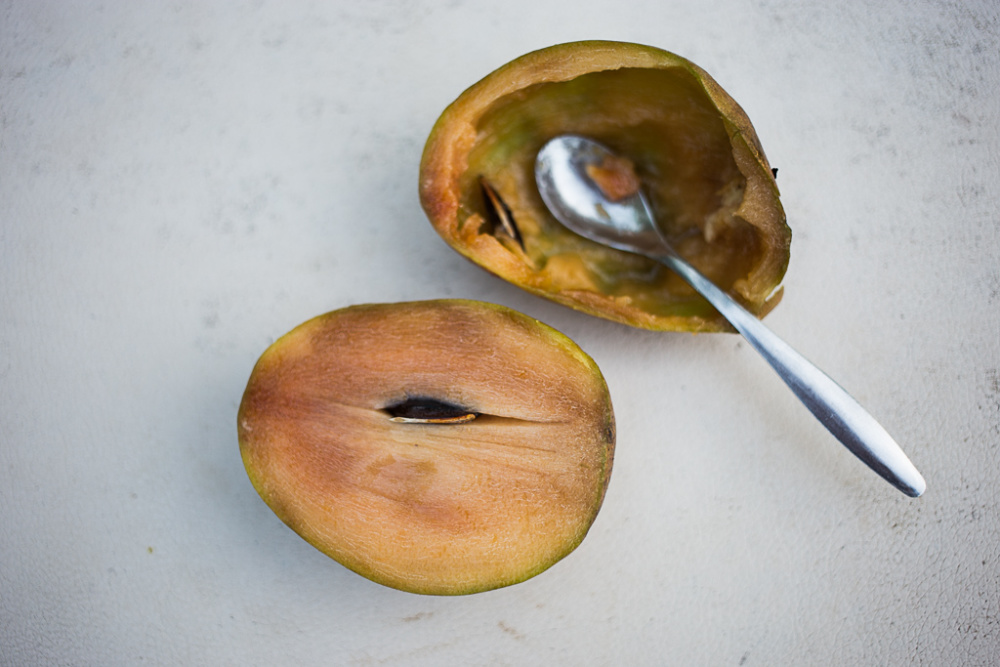
Sapodilla fruit cut in half
Climate
Sapodilla grows naturally and produces flavoursome fruit in sub-humid to humid subtropical and tropical climates, generally frost-free areas with annual lows of 13 to 25°C, annual highs of 24 to 35°C, annual rainfall of 800 to 4500 mm and a dry season of 7 months or less, extending to 12 months with irrigation or groundwater.
Sapodilla trees may fail to thrive in areas where the average low of the coldest month is below 8°C (46°F).
Growing
New plants can be started from seed, cuttings, grafting or air-layering (circumposing). Seedling trees are, however, notoriously slow-growing and take a long time to come into fruiting. Vegetatively propagated trees start flowering and fruiting when three to five years old.
Performs best on free-draining clay-loam, loam sandy-loam and loamy-sand soils of a moderately acid to alkaline nature, generally with a pH of 5.0 to 8.0, and on sites with full to partial sun exposure. It has good tolerance to limestone soils but poor tolerance to slow-draining and waterlogged soils.
There are many varieties, with differences in fruit size, shape and eating quality, and differences in climate and soil adaptability. Medium sweet varieties include 'Profilic' and 'Modello', both originating in Florida. Very sweet types include 'Brown sugar', from Florida, 'Dwarapudi' and 'Cricket Ball', from India, 'Sawo Manila', from the Philippines and 'Makok', 'Kai Hanu' and 'Krasuey' from Thailand.
Annual yields reported per tree range from fifty to two hundred fruit for South Florida, up to one thousand fruit for large trees in India.
Problem features
Birds and other animals eat the fruit and disperse the seed. Once established, it re-seeds naturally and can spread locally. It is assessed as a high weed risk species for Hawaii and Florida, respectively, by the Hawaii Pacific Weed Risk Assessment (HPWRA) project and the IFAS Assessment of Non-Native Plants in Florida's Natural Areas.
Where it grows
References
Books
-
Adams, C. D. 1972, Flowering plants of Jamaica, University of the West Indies, Mona, Greater Kingston
-
Allen, B. M. 1967, Malayan fruits : an introduction to the cultivated species, Donald Moore Press, Singapore
-
Coppen, J. J. W. 1995, Gums, resins and latexes of plant origin, Food and Agriculture Organization of the United Nations (FAO), Rome
-
Gilman, E. F. 1997, Trees for urban and suburban landscapes, Delmar Publishers, Albany, New York
-
Jensen, M. 1999, Trees commonly cultivated in Southeast Asia : an illustrated field guide, 2nd ed., Food and Agricultural Organisation of the United Nations (FAO) Regional Office for Asia and the Pacific (RAP), Bangkok
-
Khan, I. A. & Abourashed, E. A. 2010, Leung's encyclopedia of common natural ingredients : used in food, drugs and cosmetics, 3rd edition, Wiley Publishing, Hoboken, New Jersey
-
Krishen, P. 2006, Trees of Delhi : a field guide, Dorling Kindersley Publishers, Delhi
-
Macmillan, H. F. 1943, Tropical planting and gardening : with special reference to Ceylon, 5th ed, Macmillan Publishing, London
-
Mors, W. B & Rizzini, C. T. 1966, Useful plants of Brazil, Holden-Day Publishing, San Francisco, California
-
Morton, J. F. & Dowling, C. F. 1987, Fruits of warm climates, Creative Resources Systems, Winterville, North Carolina
-
Page, P. E. 1984, Tropical tree fruits for Australia, Queensland Department of Primary Industries (QLD DPI), Brisbane
-
Queensland Department of Primary Industries and Fisheries (QLD DPI) 2008, Queensland tropical fruit : the healthy flavours of North Queensland, Brisbane
-
Randall, R. P. 2002, A global compendium of weeds, R.G. and F.J. Richardson Press, Melbourne
-
Selvam, V. 2007, Trees and shrubs of the Maldives, Food and Agriculture Organisation (FAO) RAP publication (Maldives), Thammada Press Company Ltd., Bangkok
-
Shanley, P. 2002, Tapping the green market : certification and management of non-timber forest products, Earthscan Publishing, London
-
Tindall, H. D. & Rice, L. W. 1990, Fruit and vegetable production in warm climates, International ed., Macmillan, London
-
Vázquez, Y. C. 1999, Potentially valuable Mexican trees for ecological restoration and reforestation, Institute of Ecology, Database SNIB-REMIB-CONABIO, Project J084, Mexico
-
Vozzo, J. A 2002, Tropical tree seed manual, U.S. Department of Agriculture (USDA), Forest Service, Washington D.C.
Articles, Journals, Reports and Working Papers
-
Percival, S. & Findley, B. 2007 (Reviewed April 2014), What's in Your Tropical Fruit?, Fact Sheet HN 0708, University of Florida IFAS Extension Service, Gainesville, Florida
-
Watson, B.J., & Moncur, M. 1985, Guideline criteria for determining survival, commercial and best mean minimum July temperatures for various tropical fruit in Australia (Southern Hemisphere), Department of Primary Industries Queensland (DPI QLD), Wet Tropics Regional Publication, Queensland
